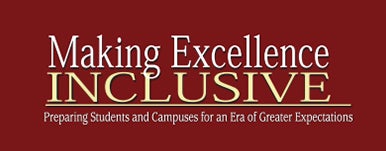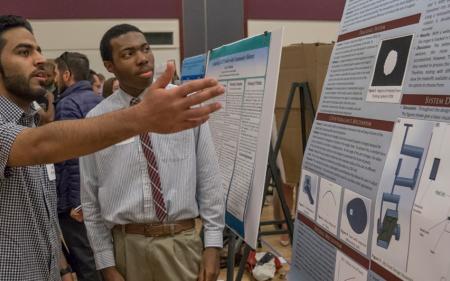Inclusive Excellence
What is Inclusive Excellence?
Inclusive Excellence (IE) is the recognition that a community or institution's success is dependent on how well it values, engages and includes the rich diversity of students, staff, faculty, administrators, and alumni constituents. This comprehensive approach requires a fundamental transformation by embedding and practicing the five dimensions of Inclusive Excellence in all that we do:
-
Intrapersonal Awareness
Intrapersonal Awareness means "engaging in a reflexive and critical examination of the ideas, assumptions, and values that we bring into the classroom" (Salazar et al., 2009, p. 210).
-
Interpersonal Awareness
Interpersonal Awareness means “building relationships and fostering dialogues that honor multiple perspectives and inviting students to share their cultural experiences” (Salazar et al., 2009, p. 213).
-
Curriculum Transformation
Curriculum Transformation means “integrating multiple identity groups into the curriculum beyond superficial multiculturalism and reviewing the curriculum for hidden forms of oppressions such as stereotyping, inaccurate generalizations, and historical omissions and making appropriate changes” (Salazar et al., 2009, p. 215).
-
Inclusive Pedagogy
Inclusive Pedagogy means “implementing teaching methods that enhance the engagement, motivation, and learning from and about historically marginalized groups” (Salazar et. al., 2009, p. 216).
-
Inclusive Learning Environment
An Inclusive Learning Environment is one where “caring for and respecting students, building professional relationships with them and ensuring safe learning environments” is the norm (Salazar et. al., 2009, p. 217).
-
Inclusive Excellence and the AAC&U
Making Excellence Inclusive and Diversity, Equity and Inclusive Excellence are the AAC&U’s guiding principle for access, student success, and high-quality learning. With a focus on the theory and practice of Inclusive Excellence; students, staff, faculty, administrators, and alumni can learn to practice the concept in order to transform their institutions.

Improved academic outcomes evidenced in higher educational aspirations, motivation, and self-confidence

Heightened creativity and innovation, and stronger critical thinking and problem-solving skills (Milem, 2003).

Increased experiences with diversity, cultural awareness, and commitment to issues of equity (Milem, 2003).

Higher levels of civic engagement and a more informed citizenry (Milem, 2003).
Recommended Reading

Getting Culture: Incorporating Diversity Across the Curriculum
How do we educate our students about cultural diversity and cultural differences, and eliminate cultural ignorance, stereotyping, and prejudice?
Read it at DUNot at DU? Order the book

Weaving Promising Practices for Inclusive Excellence Into the Higher Education Classroom
Higher education is faced with an increasingly diverse student body and historic opportunities to foster inclusive excellence.
Read it at DUNot at DU? Find the PDF online

Toward a Model of Inclusive Excellence and Change in Postsecondary Institutions
What will the next generation of work on inclusion and excellence look like? How will both our thinking and our actions need to shift?
Download the PDFIntrapersonal Awareness
Suggested practices adapted from Salazar et al., 2009, p. 211:
- Actively commit yourself to the process of self-actualization.
- Increase personal awareness of your worldview.
- Articulate where and how your worldview has developed.
- Reflect on how your intersecting social identities and positionalities inform how you show up in the classroom.
- Critically examine your own ideas, biases, assumptions, and values, and how those beliefs have an impact on your pedagogies.
- Reflect on your own biases, assumptions, and values often and frequently as you interact with students.
- Share your own background and experiences with students through the course introductions.
- Share your experience of being a student, and highlight what it took for you to succeed.
- Expand knowledge of diverse perspectives and experiences through readings about diverse cultures and identity groups, and immersing yourself in diversity.
- Develop awareness of how student beliefs, cultures, and privileges influence curriculum and pedagogies.
- Disseminate a mid-quarter anonymous survey for students to provide feedback on your facilitation of discussions and academic assessment.
- Provide opportunities for guest lecturers to come and share knowledge in areas outside of your expertise.
- If you are teaching an online course, think of ways to incorporate various voices, experiences and cultural backgrounds in ways that are genuine and relevant.
- Challenge your personal beliefs about inclusivity.
Interpersonal Awareness
Suggested practices adapted from Salazar et al., 2009, p. 211:
- Create opportunities for interpersonal dialogue where multiple perspectives are honored.
- Invite students to share cultural experiences with faculty and peers.
- Validate students' experiences by engaging in empathetic listening and asking questions openly and constructively.
- Co-create, establish and revisit communication and discussion guidelines in your classroom.
- In the first week or in your first class, have students draft a charter of class expectations and norms.
- Revisit the classroom community norms often, and ask students if they want to edit or update them.
- Provide frameworks and guidelines for students to work in groups to learn from one another.
- Monitor class discussions and interactions to recognize verbal and nonverbal communication cues in regard to conflict and microaggression.
- Recognize, assess and respond to microaggressions in real-time, you may need time to process and might just say “I recognize that something problematic has been said/written/shared/posted, and I want you all to know we will address this in our next course meeting.”
- If a microaggression occurs, be sure to check-in with the victim and ask what would be supportive, this could be an email.
- Openly invite students to share opinions, experiences, and participate in constructive conversations around the differences and similarities in those realms.
- Promote an academic perspective during critical discussions by having students engage in critical pre-reading of texts.
- Create activities and spaces in which all are invited and encouraged to share.
- Manage conflict in your courses- whether that is in person or online; and reach out to on-campus resources that can support you and/or your students in real-time.
- Open a Q& A section or virtual office space for students to bounce ideas around without instructor intervention or evaluation.
- Reflect on what it means to care about your students' intellectual growth, whole-self and wellbeing.
- Submit an SOS report when you are concerned about a student's psychosocial and/or physical wellbeing.
Inclusive Pedagogy
Suggested practices adapted from Salazar et al., 2009, p. 211:
- Recognize students' personal experiences as worthy knowledge.
- Elicit and build on students' funds of knowledge, and invite them to share this knowledge in a variety of ways.
- Establish critical dialogues with students by engaging in clearly-written epistemological, communicative and political questions.
- Facilitate classroom discussions, and monitor breakout rooms if teaching online.
- Use a variety of teaching strategies to engage all students.
- Assign students a simple concept to present to the class, and think about assigning rotating “note-takers” who then share their notes with peers.
- Use clickers/polling tools/Qualtrics to facilitate anonymous feedback and opinions for larger discussion.
- Vary the types of discussions- large, small, and think/pair/share- to help provide a space for students to participate.
- Have students complete assignments that allow them to reflect and build on their knowledge such as journals, online portfolios, etc.
- Provide opportunities for students to investigate and report on more personalized content- interviews, personal stories of survival, autobiographical writings.
- Engage students in debate, student-led discussion, read-alouds, and experiential learning activities.
- Facilitate an environment in which students feel valued as co-creators of knowledge-encourage sharing and discussion.
- Explore the principles of universal design to ensure that you are delivering course content in universally accessible ways. Examples Include: captioning videos, designing visual content layouts with universal color schemes and fonts, save pdfs as text-based formats instead of imaged based formats, captioning course graphics, providing transcripts for all recordings, etc.
- Provide opportunities for students to participate in class discussions in multiple ways (not just large group discussions).
- If appropriate, give students a variety of options to complete an assignment and still achieve the outcomes.
Inclusive Learning Environment
Suggested practices adapted from Salazar et al., 2009, p. 211:
- Demonstrate caring through attitude, expectations, and behavior.
- Demonstrate pride in student achievement, this could be as simple as intentional recognition of valuable student contributions in class.
- Engage in supportive outreach efforts such as emailing students who are struggling or absent to check-in on them.
- Pronounce students' names correctly.
- Be sure to use students’ preferred name and pronoun.
- Avoid calling on students to speak on behalf of their specific identity groups; invite contributions instead.
- Identify and build on students' interests.
- Provide students with constructive feedback in a variety of ways; ideas can include audio feedback, in-person feedback, written feedback, etc.
- Highlight areas of strength and areas of improvement with every assignment- encourage students throughout the learning process.
- Build opportunities to check-in with students to see how their quarter is going and provide resources to help students.
- Encourage students to introduce themselves in a variety of ways including video, audio, and textually. Audio introductions can allow students to pronounce their names and their preferred pronouns.
- Create opportunities to meet with students outside of class or online to answer questions.
- Give students an opportunity to share information about how they learn best so you can facilitate an inclusive learning environment.
- Reach out to students who appear to be falling behind in the course or struggling to ensure that they are connected with the appropriate campus resources.
- Provide an overview of campus resources in your course so that students can readily access them without asking.
- Indicate where the men’s, women’s, and non-gendered bathrooms are located.
- Move the furniture around to break-up artificial barriers.
- Consistently challenge racist and prejudicial remarks.
Stone Norton (2008) puts forward eight group norms that can help to create an inclusive learning environment:
- Everyone has the right to be heard
- Be respectful while still being critical
- No name calling
- One person speaks at a time
- Maintain confidentiality.
- Hold yourself and each other to high standards of excellence at all times
- Have the humility to recognize that you do not know Everything and that everyone can stand to improve
- Recognize that everyone will start from different bases of knowledge




